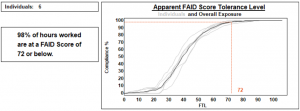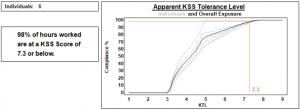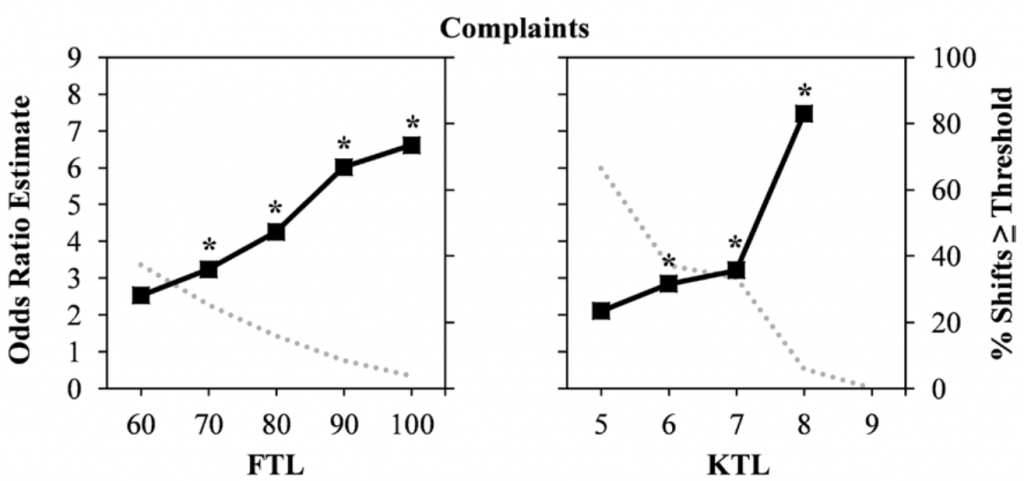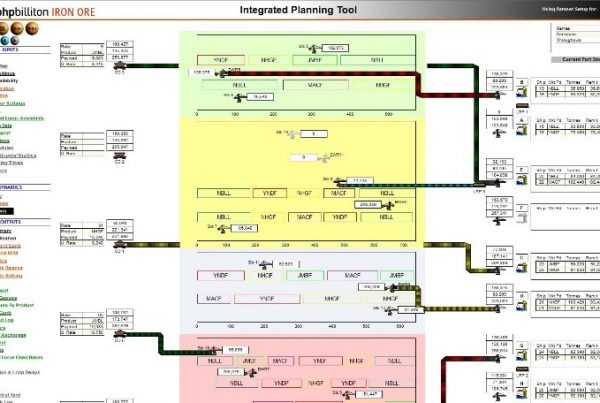Issue #65 – September 2020
Michael J. Fox once said, “Family is not an important thing. It’s everything!” In this month’s Focus on Fatigue, we will explore the topic of work-family conflict and look at ways employers and employees can reduce the tension for shift workers and their families.
The FRMS Team

InterDynamics Pty Ltd
320 Adelaide Street Brisbane Qld 4000
Tel +61 7 3229 8300
www.interdynamics.com
Views expressed in articles and links provided are those of the individual authors, and do not necessarily represent the views of InterDynamics (except where directly attributed).
Shift Work and Work-Family Conflict
Work-family conflict occurs when the demands of work interfere, or are incompatible, with family life. By nature, shift work, or nonstandard work hours, present challenges to juggling work and family that differ from those experienced with standard work hours.
How can shift work have a negative effect on personal relationships?
Shift work has been found to have modest, but significant, negative effects on familial relationships in some circumstances. These include reduced marital quality and satisfaction, less or reduced quality time with children, increased risk of teenage delinquency, and an increased risk of divorce. A New Zealand study of shift workers who worked long hours in inflexible work schedules found that isolation could also pose a problem in shift worker families, not just for the shift worker but also for the non shift working partner.
Sleep deprivation is a major issue for many shift workers, and the research around this area can also provide insight into the detrimental effects of shift work on families. Studies have found that sleep deprivation is associated with feeling less gratitude towards partners, an increase in interpersonal conflict, reduced empathy and reduced emotional control.
Can shift work have benefits for personal relationships?
The news isn’t all negative, and shift work can indeed provide opportunities that standard hours of employment may not, such as alternative child care arrangements, providing opportunities to spend more time with children during the day, and the ability to attend school functions that might otherwise be problematic. It is certainly the case that some people prefer to work night shifts because those shifts fit in better with the individual’s lifestyle or personal requirements.
Addressing work-family conflict
The issues of work-family conflict relating to shift work are most effectively addressed when seen as a joint concern for both organisations and individuals and approached both through workplace and personal strategies.
What can employers do?
While shift work and nonstandard hours are unavoidable in many industries, research has shown that the following strategies can reduce work-family conflict and increase family time adequacy, as well as increasing job satisfaction and longevity:
– Provide work schedules with advanced notice
– Offer stability in work schedule
– Offer workers greater control over scheduling
– Provide shift work training that includes family involvement and social coping strategies
– Promote a supportive culture that is reflected in policies, practices and supervisor support
What can shift worker families do to strengthen their personal relationships?
What are the most effective strategies shift workers, and their families, can use to ensure that their personal relationships are at an optimum? Unfortunately the research hasn’t yet extended as far as providing evidence-based answers to this very important question. Of course, many shift worker families use a variety of strategies that enable their family to function effectively. For those who would like a few extra hints and tricks, the following strategies have been recommended by researchers in the area:
United we stand
Maintaining a strong family unit in the face of shift work challenges is, partly, about attitude. Every member of the family must be willing to work together and make compromises when necessary. It is impossible for a shift worker to slip into the normal routine of the non-shift working family the moment they walk in the door. It is just as impossible for the non-shift working family members to arrange their lives entirely around the needs of the shift worker. This is not because the different members of the family aren’t trying hard enough, it’s just because they’re out of synch with each other. If everyone works together, perhaps the family can find ways for these two disparate routines to complement each other, instead of clashing head-on.
Recognising mood swings for what they are
As mentioned previously, sleep deprivation lowers people’s emotional stability. We get grumpy, we’re more easily irritated by little things, and we don’t always appreciate our loved ones as much as we would if we were well-rested. If a shift worker comes home from a long night shift and is grumpy, this is not because their personality has changed or because they love their family less, it’s because they need sleep. After they have slept, chances are they’ll revert back to their usual selves. The same is true for anyone who has gone too long without sleep. Recognising these sorts of minor mood swings for the temporary phenomenon they are can help family members understand what’s happening when they occur.
Planning ahead
Many shift work families talk about the importance of The Family Calendar! This is the big planner that hangs on the wall and tells everyone where everyone else is going to be. Shift times will always be the first thing the shift worker adds to the family calendar. This gives other family members an idea of when they may be able to plan time with the shift worker, even if it’s simply having a meal together as a family.
Prioritise sleep
Sleep deprivation is one of the greatest challenges facing shift workers. A lack of sleep will affect every other aspect of a shift worker’s life and, by extension, the whole family. Therefore, it is essential that after shift times are added to the family calendar, sleep times are added next. It is imperative that the family work together to protect these sleep blocks from interruption. The shift worker can ensure they are using good sleep hygiene to increase the chances of getting good quality sleep. Other family members can arrange to either be out of the house at those times, or to keep noise levels to a minimum.
A solid schedule of sleep blocks also provides reassurance for family members regarding the times they can freely make noise without interrupting the sleep of the shift worker. After all, it’s their house too and no one can be quiet all the time.
Making time for each other
After the shift roster and sleep blocks have been added to the family calender. What comes next? Family time, of course. No family can maintain strong relationships without spending time together. This includes time as a family (if children are present) and time as a couple. Quality will generally be more important than quantity. As a couple, it may be necessary to put aside two periods of time where possible. One for talking about household issues such as finances, why the lawn hasn’t been mowed, and the leaky tap in the bathroom. The second for relaxing and enjoying each other’s company.
Making time for me
Everyone needs time away from both work and family in order to maintain their individual sense of self. This may be solitary time for reflection, or it might be time catching up with friends. It may involve participation in a hobby or just reading a good book. Every member of the family in entitled to some time alone, or with friends, both those who are working shifts and those who aren’t.
Communication is key
On a practical level communication can be as simple as making sure everyone knows the roster of the shift worker, and the schedule of everyone else in the household. A shift working parent can’t attend their child’s football game, even if they’re available, if they don’t know it’s on.
On an emotional level, communication is all about checking in with each other. This can include texting during a break or leaving notes for each other. Get creative! For example, draw some simple graph lines on a small whiteboard and hang it in a well-used area of the house. One axis on the graph could indicate energy levels, ranging from ‘exhausted’ to ‘bouncing off the walls.’ The second axis could indicate mood, ranging from ‘everything is awful’ to ‘everything is awesome.’ Each family member has their own magnet to place anywhere on the graph to indicate their present emotional state. For example, Mum might be feeling a little tired (moderate on the energy scale) but she’s happy she accomplished everything she wanted to do today (high on the mood scale). This is a simple concept that can allow each member to tell others in the family how they’re doing, and when they need extra support, without having to say it in words.
When it all goes wrong
Adding shifts to the calendar, adding sleep to the calendar, making time for family, for spouses, for the individual. And don’t forget to find time to wash the dog! Put all this together and it can feel like you need 30 hours in every day just to fit it all in. This, of course, is where compromising comes in. Most people find it impossible to do everything they need to do all the time, whether they are shift workers or not. Therefore, when schedules clash, plans go out the window and the dog is still covered in mud, it will be necessary to be okay with life not working for a while. Throw your hands in the air. Move your magnet to the ‘life is awful’ part of the graph. Laugh. Give each other hugs, even if it’s in the moment before you charge out the door on the way to your next shift. Then try again tomorrow. After all, family is what life is all about!
References
- Davis, K. D., Goodman, W. B., Pirretti, A. E. and Almeida, D. M. (2008) Nonstandard work schedules, perceived family well-being, and daily stressors. Journal of Marriage and Family, 70(4), 991-1003. https://doi.org/10.1111/j.1741-3737.2008.00541.x
- Gee Wilson, M., Polzer‐Debruyne, A., Chen, S. and Fernandes, S. (2007), Shift work interventions for reduced work‐family conflict, Employee Relations, Vol. 29 No. 2, pp. 162-177. https://doi.org/10.1108/01425450710719996
- Gordon, A. M. and Chen, S. (2013) The role of sleep in interpersonal conflict: Do sleepless nights mean worse fights? Social Psychological and Personality Science, 5(2), 168-175. https://doi.org/10.1177/1948550613488952
- Handy, J. (2015) Maintaining family life under shiftwork schedules: A case study of a New Zealand Petrochemical Plant. New Zealand Journal of Psychology, 39(1), 29-37.
- Hendrix, J. A. and Parcell, T. L. (2014) Parental nonstandard work, family processes, and delinquency during adolescence. Journal of Family Issues, 35(10), 1363-1393. https://doi.org/10.1177/0192513X13510299
- Kelly, E. L., Moen, P., Oakes, J. M., Fan, W., Okechukwu, C., Davis, K. D., Hammer, L., Kossek, E., King, R. B., Hanson, G., Mierzwa, F., & Casper, L. (2014). Changing Work and Work-Family Conflict: Evidence from the Work, Family, and Health Network. American sociological review, 79(3), 485–516. https://doi.org/10.1177/0003122414531435
- Monk, T. H. and Folkard, S. (1992) Making shiftwork tolerable. Taylor & Francis: London, UK.
- That, Kadri and Mills, Melinda (2016) Out of Time: The Consequences of Non-Standard Employment Schedules for Family Cohesion. Springer Briefs in Sociology: London, UK.
- Vaghar, M. I., & Masrour, M. J. (2019). A comparative study of satisfaction and family conflicts among married nurses with different working hours. Journal of family medicine and primary care, 8(2), 472–476. https://doi.org/10.4103/jfmpc.jfmpc_395_18
- White, D. (2018) Shift work and relationships. Psych Central. Retrieved on August 5, 2020, from http://psychcentral.com/lib/shift-work-and-relationships/
- WorkCover (2020) How to manage shiftwork: Workcover NSW health and safety guide. WorkCover NSW: Gosford, NSW.
In The Research
Shift work interventions for reduced work-family conflict
Marie Gee Wilson, Andrea Polzer-Debruyne, Sopie Chen, Sonia Fernandes (2007)
Employee Relations, Vol.29 No.2, pp.162-177. https://doi.org/10.1108/01425450710719996
Abstract
Purpose – This research aims to investigate the efficacy of family involvement in shift work training targeting both physiological and social coping strategies.
Design/methodology/approach – The study utilized repeated surveys of work-family conflict (WFC) and family-work conflict (FWC) in a naturally occurring field experiment. Three small process manufacturing sites introduced training for shift workers, with or without family involvement, and with or without training on managing relational aspects of shift-work.
Findings – The inclusion of social coping strategies combined with family involvement significantly reduced work-family conflict. Open response categories on the survey suggest that these reductions were due to the facilitation of a joint problem solving approach by family members. In contrast, employee focused training on physiological coping alone appears to increase family conflicts.
Research limitations/implications – As a field study, this paper cannot control for the particularities of family situations. It should also be noted that the participants were all male, and results may have differed for female shift workers given differing family and work expectations.
Practical implications – For employers and OSH officers, this research suggests that broader spectrum training may assist shift workers in managing the requirements and impact of unsociable hours of work. For the shift worker, the research reinforces the importance of family support and family involvement in moderating shift work’s potentially negative effects.
Originality/value – This is the first study to assess the impact of family involvement in training and development-based interventions. This paper provides a unique perspective on shift work interventions by documenting both content and process effects for shift work support.
In the News
Provided below are a selection of articles from around the web on the issues associated with fatigue. We hope you find them useful and interesting.
University of Washington, Science Daily, June 2018
For the millions of Americans who work “nonstandard” shifts — evenings, nights or with rotating days off — the schedule can be especially challenging with children at home. But a new study from the University of Washington finds that consistent hours, at whatever time of day, can give families flexibility and in some cases, improve children’s behavior.
Katherine Guyot and Richard V. Reeves, Brookings, August 2020
Debates about working time tend to focus on quantity. Are American workers having to put in too many hours, especially those with caring responsibilities? This is of course a vitally important question. But it is not the only one. It matters not only how many hours people work, but how much control they have over them.
University of Illinois at Urbana-Champaign, News Bureau, Science Daily, August 2019
People who are the most optimistic tend to be better sleepers, a study of young and middle-aged adults found.
Abby Moore, Mind Body Green, December 2019
For the one in seven people who suffer from migraines, that inability to fall asleep can have even worse effects, according to new research.
University of British Columbia, Science Daily, February 2020
The scent of a romantic partner can improve sleep, suggests new psychology research.
Sophie McMullen, The Washington Post, October 2019
You may have tried a bedtime meditation or a technique such as the military method to help you fall asleep, but according to a study published last month in the Journal Psychology and Health, there’s another practice you could consider instead: forgiveness.
![]()



 While much of the discussion around workplace fatigue focuses on risk of incidents and injury, safety is not the only concern when it comes to workplace fatigue. The other effects of fatigue in the workplace may be more subtle and sometimes go unnoticed or unacknowledged. However, they can still have a considerable impact on an organisation.
While much of the discussion around workplace fatigue focuses on risk of incidents and injury, safety is not the only concern when it comes to workplace fatigue. The other effects of fatigue in the workplace may be more subtle and sometimes go unnoticed or unacknowledged. However, they can still have a considerable impact on an organisation.




